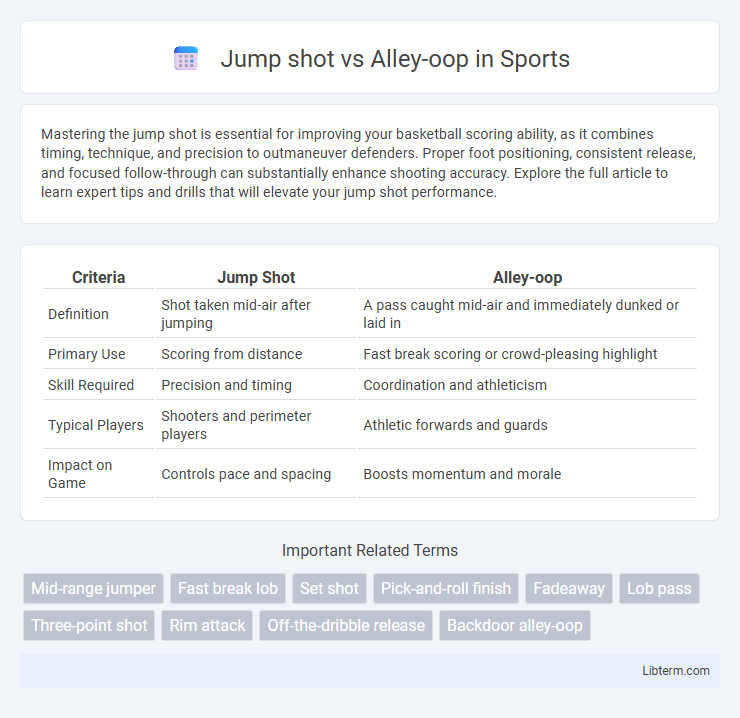Mastering the jump shot is essential for improving your basketball scoring ability, as it combines timing, technique, and precision to outmaneuver defenders. Proper foot positioning, consistent release, and focused follow-through can substantially enhance shooting accuracy. Explore the full article to learn expert tips and drills that will elevate your jump shot performance.
Table of Comparison
| Criteria | Jump Shot | Alley-oop |
|---|---|---|
| Definition | Shot taken mid-air after jumping | A pass caught mid-air and immediately dunked or laid in |
| Primary Use | Scoring from distance | Fast break scoring or crowd-pleasing highlight |
| Skill Required | Precision and timing | Coordination and athleticism |
| Typical Players | Shooters and perimeter players | Athletic forwards and guards |
| Impact on Game | Controls pace and spacing | Boosts momentum and morale |
Jump Shot vs Alley-oop: Key Differences
Jump shots involve a player shooting the basketball while airborne, typically from mid-range or long distance, emphasizing accuracy and form. Alley-oops involve one player throwing a lob pass near the rim while a teammate jumps, catches the ball mid-air, and scores in a single motion, highlighting teamwork and athleticism. The primary difference lies in the jump shot being a solo scoring attempt versus the alley-oop requiring coordinated passing and timing between players.
Mechanics of a Jump Shot
The mechanics of a jump shot involve precise foot placement, a fluid upward motion, and a well-timed release to achieve accurate shooting form. Proper alignment of the shooting elbow and follow-through with the wrist create backspin, enhancing ball control and trajectory. In contrast to the alley-oop, which emphasizes timing and coordination for a mid-air catch and dunk, the jump shot relies on individual technique and balance for scoring from distance.
How the Alley-oop Works
The alley-oop involves one player throwing the basketball near the basket while a teammate jumps, catches the ball mid-air, and scores in a single motion, often with a dunk or layup. This play relies on precise timing, coordination, and vertical leap to outmaneuver defenders. Unlike a jump shot, which requires shooting accuracy and release technique, the alley-oop maximizes athleticism and teamwork for an impactful scoring opportunity.
Historical Origins of Each Move
The jump shot originated in the 1930s, revolutionizing basketball by allowing players to shoot over defenders with increased accuracy and elevation. The alley-oop developed later, gaining popularity in the 1970s as a dynamic play involving one player tossing the ball near the basket and a teammate leaping to catch and dunk it mid-air. Both moves transformed offensive strategies and remain fundamental skills in modern basketball gameplay.
Impact on Team Strategy
Jump shots provide consistent mid-range or long-range scoring options that help spread the floor and create spacing, enhancing offensive versatility. Alley-oops capitalize on timing and athleticism, often resulting in high-percentage dunks that energize the team and shift momentum rapidly. Integrating both techniques diversifies scoring threats, forcing defenses to adapt and opening opportunities for improved ball movement and offensive efficiency.
Player Skill Sets Required
Mastering a jump shot demands precise hand-eye coordination, consistent shooting form, and strong lower body strength to generate power and stability. Executing an alley-oop requires exceptional timing, vertical leap ability, and spatial awareness to catch and dunk or lay up the ball mid-air seamlessly. Both skills highlight different athletic proficiencies: jump shots emphasize shooting accuracy and technique, while alley-oops showcase explosive athleticism and coordination between teammates.
Situational Effectiveness on the Court
Jump shots offer reliable scoring options from mid-range or beyond the arc, making them effective for creating space against tight defenses or when isolation plays are required. Alley-oops capitalize on timing and athleticism, excelling in fast-break situations or when facing defenders who struggle to contest above the rim. Coaches often deploy jump shots in half-court sets for consistent point accumulation, while alley-oops serve as high-impact plays during transition or when exploiting mismatches near the basket.
Highlight Moments in Basketball History
Michael Jordan's clutch jump shots in the 1998 NBA Finals remain iconic for their precision and game-winning impact, defining highlight moments in basketball history. Contrast this with Julius Erving's legendary alley-oop dunks in the 1980 NBA Finals, which showcased athleticism and elevated the alley-oop as a spectacle. These contrasting highlights emphasize the jump shot's strategic finesse versus the alley-oop's explosive showmanship on the court.
Training Tips for Mastery
Mastering the jump shot requires focused drills on proper foot positioning, wrist flick, and follow-through to ensure consistent accuracy and power. Training for alley-oops emphasizes explosive vertical leap, timing with the passer, and catching mid-air under pressure to coordinate seamless finishes. Incorporate plyometric exercises and repetitive catch-and-shoot practice to enhance muscle memory and on-court reaction speed for both techniques.
Choosing the Right Move: Game Scenarios
A jump shot offers reliable scoring from mid to long range, making it ideal for situations where defenders are closely guarding and space is limited. An alley-oop excels in fast-break scenarios or when teammates capitalize on height and timing to finish near the rim. Selecting between a jump shot and an alley-oop depends on court spacing, defender positioning, and player athleticism to maximize scoring efficiency.
Jump shot Infographic

 libterm.com
libterm.com